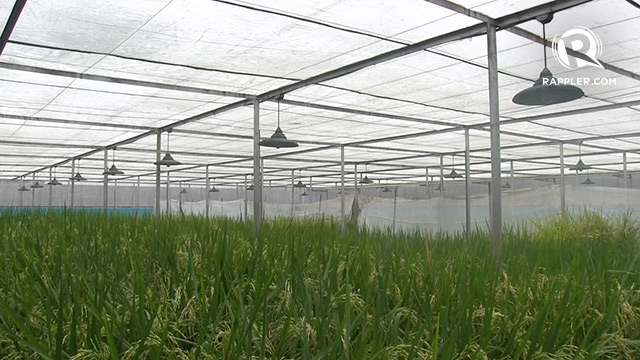SUMMARY
This is AI generated summarization, which may have errors. For context, always refer to the full article.

LAGUNA, Philippines – The Philippines is seen as a crucial battleground for genetically-modified organisms or GMOs.
After a court bans field trials for the genetically modified eggplant, both anti and pro-GMO lobbyists are gearing up for the imminent approval of tests for the Golden Rice.
Pia Ranada reports.
These rice stalks at the International Rice Research Institute may look typical but the grains they produce are a margarine-yellow.
Golden Rice gets its color from a gene inserted from corn and a soil bacteria.
The gene gives the rice beta carotene which generates Vitamin A when eaten.
Golden Rice is being marketed as the cure to Vitamin A deficiency, a leading cause of blindness in the world.
BRUCE TOLENTINO
DEPUTY DIRECTOR, INTERNATIONAL RICE RESEARCH INSTITUTE
In the Philippines alone, 2 million women and children are affected by Vitamin A deficiency. We have to deal with that. The fact is that Filipinos eat a lot of rice. On the average we eat 123 kilos per head per year. So since rice is so much a part of our diet, why don’t we improve it?
Golden Rice is now undergoing multi-location field trials in different parts of the Philippines.
It needs to pass 3 more tests before making it to the dining tables.
But not everyone is convinced by the noble goals of Golden Rice.
CHITO MEDINA
NATIONAL COORDINATOR, MASIPAG
Vitamin A rice actually is a Trojan horse or a poster boy of GMO companies in order to increase the acceptability of GMOs throughout the world. Vitamin A rice produces only 38 micrograms per gram and carrots can produce 130 microgram per gram. It means to say carrots can produce 3 times more vitamin A than golden rice.
Golden Rice is at the forefront of a larger debate on GMOs.
One side sees GMOs as a science used for good.
BRUCE TOLENTINO
DEPUTY DIRECTOR, INTERNATIONAL RICE RESEARCH INSTITUTE
We need science to solve the food security problems brought about by rapid population growth. We need to solve the problems brought about by climate change and what is happening to the environment. We need science to ensure that our family, friends and children have nutritious food that they need.
The other side says GMOs will put companies in control of agriculture at the expense of poor farmers.
Farmer alliance Masipag’s spokesman Chito Medina says farmers are already experiencing this problem
CHITO MEDINA
NATIONAL COORDINATOR, MASIPAG
The data that we get from a formal study last year shows that the farmers are spending something like 5,000 pesos on top of the cost of normal hybrid corn produced by the same company. Even if the gross income has increased, the net income has declined because of the greater increase in the cost of production. Farmers use GM corn even if they have a choice because if they borrow money the money lenders require that the farmers plant GM corn.
Boon or bane? It’s the perennial question when technology tinkers with our food.
As the court battle nears, the global spotlight is on the Philippines.
Advocates say if Golden Rice is approved here, it will be very hard to stop the technology in other parts of the world.
Pia Ranada, Rappler, Manila. – Rappler.com
Add a comment
How does this make you feel?
There are no comments yet. Add your comment to start the conversation.